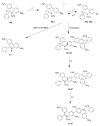Hydroethidine- and MitoSOX-derived red fluorescence is not a reliable indicator of intracellular superoxide formation: another inconvenient truth
- PMID: 20116425
- PMCID: PMC3587154
- DOI: 10.1016/j.freeradbiomed.2010.01.028
Hydroethidine- and MitoSOX-derived red fluorescence is not a reliable indicator of intracellular superoxide formation: another inconvenient truth
Abstract
Hydroethidine (HE; or dihydroethidium) is the most popular fluorogenic probe used for detecting intracellular superoxide radical anion. The reaction between superoxide and HE generates a highly specific red fluorescent product, 2-hydroxyethidium (2-OH-E(+)). In biological systems, another red fluorescent product, ethidium, is also formed, usually at a much higher concentration than 2-OH-E(+). In this article, we review the methods to selectively detect the superoxide-specific product (2-OH-E(+)) and the factors affecting its levels in cellular and biological systems. The most important conclusion of this review is that it is nearly impossible to assess the intracellular levels of the superoxide-specific product, 2-OH-E(+), using confocal microscopy or other fluorescence-based microscopic assays and that it is essential to measure by HPLC the intracellular HE and other oxidation products of HE, in addition to 2-OH-E(+), to fully understand the origin of red fluorescence. The chemical reactivity of mitochondria-targeted hydroethidine (Mito-HE, MitoSOX red) with superoxide is similar to the reactivity of HE with superoxide, and therefore, all of the limitations attributed to the HE assay are applicable to Mito-HE (or MitoSOX) as well.
Copyright 2010 Elsevier Inc. All rights reserved.
Figures






Similar articles
-
HPLC-based monitoring of products formed from hydroethidine-based fluorogenic probes--the ultimate approach for intra- and extracellular superoxide detection.Biochim Biophys Acta. 2014 Feb;1840(2):739-44. doi: 10.1016/j.bbagen.2013.05.008. Epub 2013 May 10. Biochim Biophys Acta. 2014. PMID: 23668959 Free PMC article. Review.
-
Detection of 2-hydroxyethidium in cellular systems: a unique marker product of superoxide and hydroethidine.Nat Protoc. 2008;3(1):8-21. doi: 10.1038/nprot.2007.473. Nat Protoc. 2008. PMID: 18193017
-
Cytochrome c-mediated oxidation of hydroethidine and mito-hydroethidine in mitochondria: identification of homo- and heterodimers.Free Radic Biol Med. 2008 Mar 1;44(5):835-46. doi: 10.1016/j.freeradbiomed.2007.11.013. Epub 2007 Dec 4. Free Radic Biol Med. 2008. PMID: 18155177 Free PMC article.
-
Selective fluorescent imaging of superoxide in vivo using ethidium-based probes.Proc Natl Acad Sci U S A. 2006 Oct 10;103(41):15038-43. doi: 10.1073/pnas.0601945103. Epub 2006 Oct 2. Proc Natl Acad Sci U S A. 2006. PMID: 17015830 Free PMC article.
-
Oxidative chemistry of fluorescent dyes: implications in the detection of reactive oxygen and nitrogen species.Biochem Soc Trans. 2011 Oct;39(5):1221-5. doi: 10.1042/BST0391221. Biochem Soc Trans. 2011. PMID: 21936793 Review.
Cited by
-
Reactive oxygen species function as signaling molecules in controlling plant development and hormonal responses.Curr Opin Plant Biol. 2022 Oct;69:102293. doi: 10.1016/j.pbi.2022.102293. Epub 2022 Sep 10. Curr Opin Plant Biol. 2022. PMID: 36099672 Free PMC article. Review.
-
Use of fluorescent probes for ROS to tease apart Type I and Type II photochemical pathways in photodynamic therapy.Methods. 2016 Oct 15;109:158-166. doi: 10.1016/j.ymeth.2016.06.025. Epub 2016 Jul 1. Methods. 2016. PMID: 27374076 Free PMC article. Review.
-
Low micromolar concentrations of the superoxide probe MitoSOX uncouple neural mitochondria and inhibit complex IV.Free Radic Biol Med. 2015 Sep;86:250-8. doi: 10.1016/j.freeradbiomed.2015.05.032. Epub 2015 Jun 6. Free Radic Biol Med. 2015. PMID: 26057935 Free PMC article.
-
Live-cell imaging approaches for the investigation of xenobiotic-induced oxidant stress.Biochim Biophys Acta. 2016 Dec;1860(12):2802-15. doi: 10.1016/j.bbagen.2016.05.017. Epub 2016 May 18. Biochim Biophys Acta. 2016. PMID: 27208426 Free PMC article. Review.
-
Alterations in bioenergetic function induced by Parkinson's disease mimetic compounds: lack of correlation with superoxide generation.J Neurochem. 2012 Sep;122(5):941-51. doi: 10.1111/j.1471-4159.2012.07836.x. Epub 2012 Jul 11. J Neurochem. 2012. PMID: 22708893 Free PMC article.
References
-
- Fridovich I. Superoxide dismutases. An adaptation to a paramagnetic gas. J Biol Chem. 1989;264:7761–7764. - PubMed
-
- Fridovich I. Superoxide anion radical (O2-.), superoxide dismutases, and related matters. J Biol Chem. 1997;272:18515–18517. - PubMed
-
- Fridovich I. Oxygen toxicity: a radical explanation. J Exp Biol. 1998;201:1203–1209. - PubMed
-
- Fridovich I. Superoxide radical and superoxide dismutase. Acc Chem Res. 1972;5:321–326.
-
- McCord JM, Fridovich I. Superoxide dismutase. An enzymic function for erythrocuprein (hemocuprein) J Biol Chem. 1969;244:6049–6055. - PubMed
Publication types
MeSH terms
Substances
Grants and funding
LinkOut - more resources
Full Text Sources
Other Literature Sources

